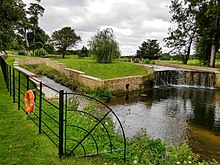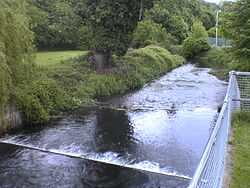|
River Beane
The River Beane is a short river in the county of Hertfordshire, England. A tributary of the River Lea, it rises to the south-west of Sandon in the hills northeast of Stevenage and joins the Lea at Hartham Common in Hertford. WatermillsIn medieval times there were a number of watermills along the course of the Beane. A few of the buildings and mill races survive.
AbstractionThe Beane valley remains mainly rural in character. However, Hertfordshire's population increased substantially in the second half of the twentieth century, and the consequent demand for water has affected rivers such as the Beane and the Mimram. In the case of the Beane, a licence was given to abstract water near Aston for Stevenage's water supply. The river has since been adversely affected by over-exploitation of the chalk aquifer in its upper reaches. The photo shows a dry section south of Walkern where from the 1990s until about 2014 there was only seasonal flow. An indication of the scale of the decline in flow is that the section at Walkern was once big enough to power a watermill and to support watercress beds.[2]  The lower Beane is more robust and there has continued to be regular flow through Watton-at-Stone, Stapleford and Waterford until the confluence with the River Lea. However, overall the river has performed badly in assessments by the Environment Agency of flow level. RestorationThe state of the upper Beane resulted in calls for the river's restoration.[6] The management plan for the river includes the objective that there is adequate flow along the length of the river to support a ‘good status’ chalk stream ecology (as defined by the European Union's Water Framework Directive). [7] One possible approach to the restoration of the upper Beane which was discussed was to use recycled water from sewage treatment works. For decades sewage from the Stevenage area has bypassed the river, being pumped down the Beane valley to Rye Meads near Hertford for treatment and eventual discharge into the River Stort. However, the water could theoretically have been discharged into the Beane if treated further upstream.[8] In the event another option was chosen. Affinity Water was told to take less water from its pumping station near Aston, even though obtaining water from a less environmentally damaging source was difficult as the River Lea's catchment area as a whole is under pressure.  There have been initiatives to improve the condition of lower stretches of the river, where there are issues regarding water quality and weirs. For example, where it passes through the Woodhall Park estate (near Watton) the river has been modified by an 18th-century landscaping project. This had the adverse consequence of impeding fish passage and a channel has now been constructed which by-passes the obstruction.[9][10] AccessHerts and Middlesex Wildlife Trust (HMWT) has launched a circular trail at Waterford, which includes some scenic sections of the River Beane. References
External linksWikimedia Commons has media related to River Beane. |
||||||||||||||||||||||||||


